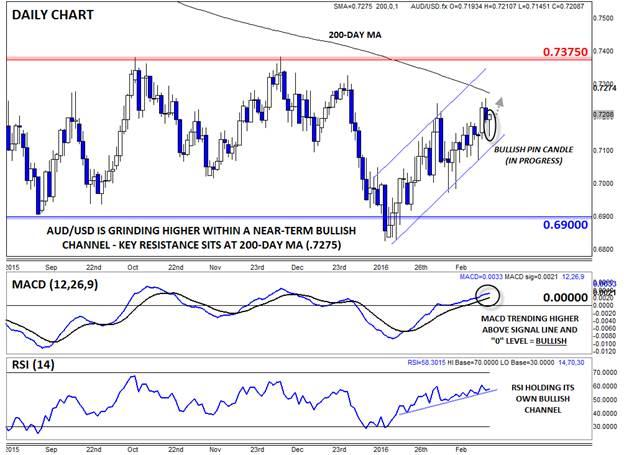![]()
My, what a difference a couple of hours makes. As US traders trudged into their offices this morning, it seemed as though the sky was falling: continued fears of Brexit were driving GBP/USD to 7-year lows, major equity markets were trading down by about 2% across the board, and oil (WTI) was falling back toward the widely-watched 30.00 level. Since then, each of those moves has been unwound to some extent, and in fact, both US equities and oil have turned positive on the day as of writing.
The recovery in global risk sentiment has also had a beneficial effect on AUD/USD, which hit a 7-week high near .7260 yesterday before pulling back overnight. More to the point, the pair is now approaching its widely-watched 200-day moving average; the last time AUD/USD traded above its 200-day MA was all the way back in Q3 of 2014. So far today, the price action has created a potential Bullish Pin (Hammer) candle* on the daily chart, underscoring the intraday reversal from selling to buying pressure. With rates essentially holding their own in the .6900-.7400 zone for a couple of months now, a break above the 200-day MA could start to convince some longer-term traders that the trend is finally turning back to the topside.
The secondary indicators are also relatively constructive. The MACD is trending higher above both its signal line and the “0” level, showing bullish momentum, whereas the RSI is rising within a bullish trend, mirroring the recent moves in the AUD/USD exchange rate itself.
Looping back around to the fundamental picture, the biggest report to watch for the rest of the week will be tonight’s AU Private Capital Expenditures report. CapEx has declined Down Under in each of the last four quarters, and another decline of -3.1% is expected in today’s Asian session. That said, if CapEx falls less than anticipated, it could be a sign that the AU economy is on better footing than widely expected and could push AUD/USD up to test the 200-day AM at .7275 later this week. If we see another worse-than-anticipated reading on CapEx though, AUD/USD could fall to the bottom of its near-term bullish channel near .7100.
This research is for informational purposes and should not be construed as personal advice. Trading any financial market involves risk. Trading on leverage involves risk of losses greater than deposits.
Recommended Content
Editors’ Picks
EUR/USD holds above 1.0700 ahead of key US data

EUR/USD trades in a tight range above 1.0700 in the early European session on Friday. The US Dollar struggles to gather strength ahead of key PCE Price Index data, the Fed's preferred gauge of inflation, and helps the pair hold its ground.
USD/JPY jumps above 156.00 on BoJ's steady policy

USD/JPY has come under intense buying pressure, surging past 156.00 after the Bank of Japan kept the key rate unchanged but tweaked its policy statement. The BoJ maintained its fiscal year 2024 and 2025 core inflation forecasts, disappointing the Japanese Yen buyers.
Gold price flatlines as traders look to US PCE Price Index for some meaningful impetus

Gold price lacks any firm intraday direction and is influenced by a combination of diverging forces. The weaker US GDP print and a rise in US inflation benefit the metal amid subdued USD demand. Hawkish Fed expectations cap the upside as traders await the release of the US PCE Price Index.
Sei Price Prediction: SEI is in the zone of interest after a 10% leap

Sei price has been in recovery mode for almost ten days now, following a fall of almost 65% beginning in mid-March. While the SEI bulls continue to show strength, the uptrend could prove premature as massive bearish sentiment hovers above the altcoin’s price.
US core PCE inflation set to signal firm price pressures as markets delay Federal Reserve rate cut bets

The core PCE Price Index, which excludes volatile food and energy prices, is seen as the more influential measure of inflation in terms of Fed positioning. The index is forecast to rise 0.3% on a monthly basis in March, matching February’s increase.
